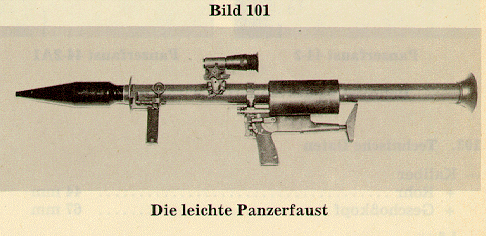Panzerfaust

Developed in 1943, the Panzerfaust I (‘‘Larger’’) was simplicity itself: a hollow tube 800 mm (thirty-two inches) long firing a 150 mm (six-inch) diameter grenade that projected ten inches beyond the front of the tube. It was fired by depressing a button that released a spring that in turn detonated black-powder propellant. The grenade’s 6.13-pound warhead contained a 3.6-pound bursting charge. Effective range was thirty meters, though sights on some models were calibrated to seventy-five meters. A loaded Panzerfaust weighed about 11.7 pounds—comparable to the unloaded American bazooka. The Panzerfaust II was known as ‘‘Smaller’’ because its 3.9-inch projectile yielded an ‘‘all up’’ weight of only 7.1 pounds. Its effective range was also about thirty meters, but the 1.6-pound bursting charge could not penetrate armor of the same thickness. By May 1944 production had reached four hundred thousand units.
Thousands of Panzerfauste were captured, and Maj. Gen. James M. Gavin intended to issue one to nearly every trooper in the Eight-second Airborne Division for the planned jump into Templehoff Airport in Berlin. However, the German capitol fell within the Soviet zone, so the operation never proceeded.
WW2 Weapons: Overview of WW2 Combat Innovation - History. PzF 44 - Wikipedia.
The PzF 44 (abbreviation for Panzerfaust 44 mm , formally also Leichte Panzerfaust ,[1] meaning “Light tank-fist”, also known as Panzerfaust Lanze (lance) and Panzerfaust 2/Panzerfaust II ), was a West German portable recoilless shoulder-fired anti-tank rocket launcher with a barrel-caliber of 44 mm (1.7 in). It was the spiritual successor to the Panzerfaust from World War II and served with the West German Army from the early 1960s to the early 1990s, when it was replaced by the Panzerfaust 3 semi-disposable launcher.